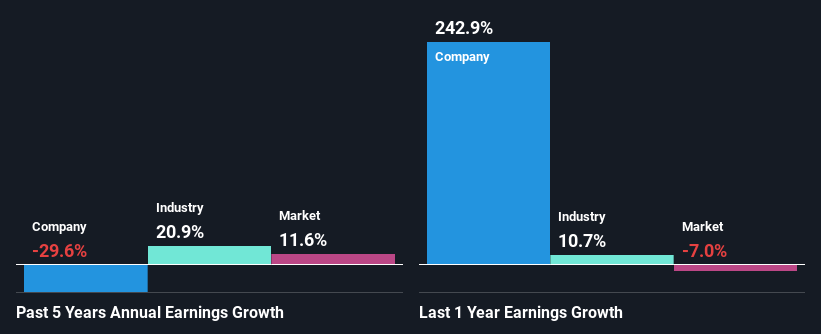Stock Analysis
- Singapore
- /
- Specialty Stores
- /
- SGX:5SO
Are Duty Free International Limited's (SGX:5SO) Mixed Financials The Reason For Its Gloomy Performance on The Stock Market?

Duty Free International (SGX:5SO) has had a rough three months with its share price down 25%. It is possible that the markets have ignored the company's differing financials and decided to lean-in to the negative sentiment. Fundamentals usually dictate market outcomes so it makes sense to study the company's financials. Particularly, we will be paying attention to Duty Free International's ROE today.
Return on Equity or ROE is a test of how effectively a company is growing its value and managing investors’ money. In short, ROE shows the profit each dollar generates with respect to its shareholder investments.
See our latest analysis for Duty Free International
How Do You Calculate Return On Equity?
Return on equity can be calculated by using the formula:
Return on Equity = Net Profit (from continuing operations) ÷ Shareholders' Equity
So, based on the above formula, the ROE for Duty Free International is:
5.1% = RM18m ÷ RM351m (Based on the trailing twelve months to August 2023).
The 'return' is the amount earned after tax over the last twelve months. So, this means that for every SGD1 of its shareholder's investments, the company generates a profit of SGD0.05.
What Is The Relationship Between ROE And Earnings Growth?
So far, we've learned that ROE is a measure of a company's profitability. We now need to evaluate how much profit the company reinvests or "retains" for future growth which then gives us an idea about the growth potential of the company. Assuming all else is equal, companies that have both a higher return on equity and higher profit retention are usually the ones that have a higher growth rate when compared to companies that don't have the same features.
Duty Free International's Earnings Growth And 5.1% ROE
At first glance, Duty Free International's ROE doesn't look very promising. A quick further study shows that the company's ROE doesn't compare favorably to the industry average of 9.2% either. Therefore, it might not be wrong to say that the five year net income decline of 30% seen by Duty Free International was probably the result of it having a lower ROE. We reckon that there could also be other factors at play here. For instance, the company has a very high payout ratio, or is faced with competitive pressures.
However, when we compared Duty Free International's growth with the industry we found that while the company's earnings have been shrinking, the industry has seen an earnings growth of 21% in the same period. This is quite worrisome.

The basis for attaching value to a company is, to a great extent, tied to its earnings growth. What investors need to determine next is if the expected earnings growth, or the lack of it, is already built into the share price. Doing so will help them establish if the stock's future looks promising or ominous. If you're wondering about Duty Free International's's valuation, check out this gauge of its price-to-earnings ratio, as compared to its industry.
Is Duty Free International Making Efficient Use Of Its Profits?
Looking at its three-year median payout ratio of 47% (or a retention ratio of 53%) which is pretty normal, Duty Free International's declining earnings is rather baffling as one would expect to see a fair bit of growth when a company is retaining a good portion of its profits. So there could be some other explanations in that regard. For instance, the company's business may be deteriorating.
Additionally, Duty Free International has paid dividends over a period of at least ten years, which means that the company's management is determined to pay dividends even if it means little to no earnings growth.
Summary
On the whole, we feel that the performance shown by Duty Free International can be open to many interpretations. While the company does have a high rate of reinvestment, the low ROE means that all that reinvestment is not reaping any benefit to its investors, and moreover, its having a negative impact on the earnings growth. Wrapping up, we would proceed with caution with this company and one way of doing that would be to look at the risk profile of the business. Our risks dashboard would have the 3 risks we have identified for Duty Free International.
Valuation is complex, but we're helping make it simple.
Find out whether Duty Free International is potentially over or undervalued by checking out our comprehensive analysis, which includes fair value estimates, risks and warnings, dividends, insider transactions and financial health.
View the Free AnalysisHave feedback on this article? Concerned about the content? Get in touch with us directly. Alternatively, email editorial-team (at) simplywallst.com.
This article by Simply Wall St is general in nature. We provide commentary based on historical data and analyst forecasts only using an unbiased methodology and our articles are not intended to be financial advice. It does not constitute a recommendation to buy or sell any stock, and does not take account of your objectives, or your financial situation. We aim to bring you long-term focused analysis driven by fundamental data. Note that our analysis may not factor in the latest price-sensitive company announcements or qualitative material. Simply Wall St has no position in any stocks mentioned.
About SGX:5SO
Duty Free International
Duty Free International Limited, an investment holding company, trades in duty free merchandise under the Zon brand in Malaysia.
Flawless balance sheet unattractive dividend payer.

